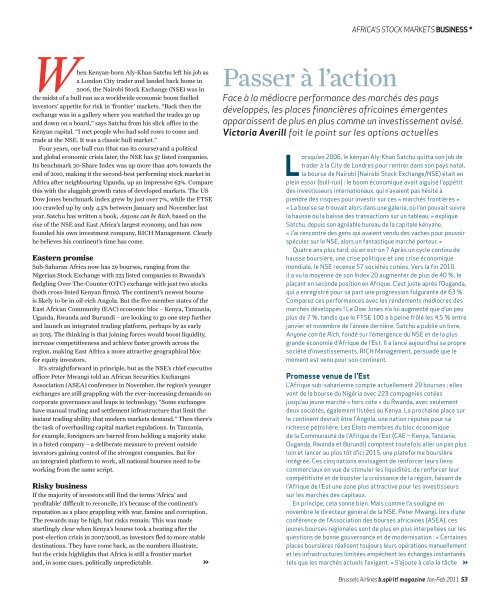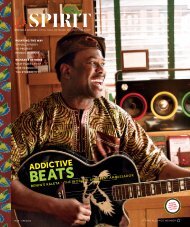You also want an ePaper? Increase the reach of your titles
YUMPU automatically turns print PDFs into web optimized ePapers that Google loves.
When Kenyan-born Aly-Khan Satchu left his job as<br />
a London City trader and landed back home in<br />
2006, the Nairobi Stock Exchange (NSE) was in<br />
the midst of a bull run as a worldwide economic boom fuelled<br />
investors’ appetite for risk in ‘frontier’ markets. “Back then the<br />
exchange was in a gallery where you watched the trades go up<br />
and down on a board,” says Satchu from his slick office in the<br />
Kenyan capital. “I met people who had sold cows to come and<br />
trade at the NSE. It was a classic bull market.”<br />
Four years, one bull run (that ran its course) and a political<br />
and global economic crisis later, the NSE has 57 listed companies.<br />
Its benchmark 20-Share Index was up more than 40% towards the<br />
end of 2010, making it the second-best performing stock market in<br />
Africa after neighbouring Uganda, up an impressive 63%. Compare<br />
this with the sluggish growth rates of developed markets. The US<br />
Dow Jones benchmark index grew by just over 7%, while the FTSE<br />
100 crawled up by only 4.5% between January and November last<br />
year. Satchu has written a book, Anyone can be Rich, based on the<br />
rise of the NSE and East Africa’s largest economy, and has now<br />
founded his own investment company, RICH Management. Clearly<br />
he believes his continent’s time has come.<br />
Eastern promise<br />
Sub-Saharan Africa now has 29 bourses, ranging from the<br />
Nigerian Stock Exchange with 223 listed companies to Rwanda’s<br />
fledgling Over-The-Counter (OTC) exchange with just two stocks<br />
(both cross-listed Kenyan firms). The continent’s newest bourse<br />
is likely to be in oil-rich Angola. But the five member states of the<br />
East African Community (EAC) economic bloc – Kenya, Tanzania,<br />
Uganda, Rwanda and Burundi – are looking to go one step further<br />
and launch an integrated trading platform, perhaps by as early<br />
as 2015. The thinking is that joining forces would boost liquidity,<br />
increase competitiveness and achieve faster growth across the<br />
region, making East Africa a more attractive geographical bloc<br />
for equity investors.<br />
It’s straightforward in principle, but as the NSE’s chief executive<br />
officer Peter Mwangi told an African Securities Exchanges<br />
Association (ASEA) conference in November, the region’s younger<br />
exchanges are still grappling with the ever-increasing demands on<br />
corporate governance and leaps in technology: “Some exchanges<br />
have manual trading and settlement infrastructure that limit the<br />
instant trading ability that modern markets demand.” Then there’s<br />
the task of overhauling capital market regulations. In Tanzania,<br />
for example, foreigners are barred from holding a majority stake<br />
in a listed company – a deliberate measure to prevent outside<br />
investors gaining control of the strongest companies. But for<br />
an integrated platform to work, all national bourses need to be<br />
working from the same script.<br />
Risky business<br />
If the majority of investors still find the terms ‘Africa’ and<br />
‘profitable’ difficult to reconcile, it’s because of the continent’s<br />
reputation as a place grappling with war, famine and corruption.<br />
The rewards may be high, but risks remain. This was made<br />
startlingly clear when Kenya’s bourse took a beating after the<br />
post-election crisis in 2007/2008, as investors fled to more stable<br />
destinations. They have come back, as the numbers illustrate,<br />
but the crisis highlights that Africa is still a frontier market<br />
and, in some cases, politically unpredictable.<br />
Passer à l’action<br />
AFRICA’S STOCK MARKETS BUSINESS *<br />
Face à la médiocre performance des marchés des pays<br />
développés, les places financières africaines émergentes<br />
apparaissent de plus en plus comme un investissement avisé.<br />
Victoria Averill fait le point sur les options actuelles<br />
Lorsqu’en 2006, le kényan Aly-Khan Satchu quitta son job de<br />
trader à la City de Londres pour rentrer dans son pays natal,<br />
la bourse de Nairobi (Nairobi Stock Exchange/NSE) était en<br />
plein essor (bull-run) : le boom économique avait aiguisé l’appétit<br />
des investisseurs internationaux, qui n’avaient pas hésité à<br />
prendre des risques pour investir sur ces « marchés frontières ».<br />
« La bourse se trouvait alors dans une galerie, où l’on pouvait suivre<br />
la hausse ou la baisse des transactions sur un tableau, » explique<br />
Satchu, depuis son agréable bureau de la capitale kényane.<br />
« J’ai rencontré des gens qui avaient vendu des vaches pour pouvoir<br />
spéculer sur le NSE, alors un fantastique marché porteur. »<br />
Quatre ans plus tard, où en est-on ? Après un cycle continu de<br />
hausse boursière, une crise politique et une crise économique<br />
mondiale, le NSE recense 57 sociétés cotées. Vers la fin 2010,<br />
il a vu la moyenne de son Index 20 augmenter de plus de 40 %, le<br />
plaçant en seconde position en Afrique. C’est juste après l’Ouganda,<br />
qui a enregistré pour sa part une progression fulgurante de 63 %.<br />
Comparez ces performances avec les rendements médiocres des<br />
marchés développés ! Le Dow Jones n’a lui augmenté que d’un peu<br />
plus de 7 %, tandis que le FTSE 100 a à peine frôlé les 4,5 % entre<br />
janvier et novembre de l’année dernière. Satchu a publié un livre,<br />
Anyone can be Rich, fondé sur l’émergence du NSE et de la plus<br />
grande économie d’Afrique de l’Est. Il a lancé aujourd’hui sa propre<br />
société d’investissements, RICH Management, persuadé que le<br />
moment est venu pour son continent.<br />
Promesse venue de l’Est<br />
L’Afrique sub-saharienne compte actuellement 29 bourses ; elles<br />
vont de la bourse du Nigéria avec 223 compagnies cotées<br />
jusqu’au jeune marché « hors cote » du Rwanda, avec seulement<br />
deux sociétés, également listées au Kenya. La prochaine place sur<br />
le continent devrait être l’Angola, une nation réputée pour sa<br />
richesse pétrolière. Les États membres du bloc économique<br />
de la Communauté de l’Afrique de l’Est (CAE – Kenya, Tanzanie,<br />
Ouganda, Rwanda et Burundi) comptent toutefois aller un pas plus<br />
loin et lancer au plus tôt d’ici 2015, une plateforme boursière<br />
intégrée. Ces cinq nations envisagent de renforcer leurs liens<br />
commerciaux en vue de stimuler les liquidités, de renforcer leur<br />
compétitivité et de booster la croissance de la région, faisant de<br />
l’Afrique de l’Est une zone plus attractive pour les investisseurs<br />
sur les marchés des capitaux.<br />
En principe, cela sonne bien. Mais comme l’a souligné en<br />
novembre le directeur général de la NSE, Peter Mwangi, lors d’une<br />
conférence de l’Association des bourses africaines (ASEA), ces<br />
jeunes bourses régionales sont de plus en plus interpellées sur les<br />
questions de bonne gouvernance et de modernisation : « Certaines<br />
places boursières réalisent toujours leurs opérations manuellement<br />
et les infrastructures limitées empêchent les échanges instantanés<br />
tels que les marchés actuels l’exigent. » S’ajoute à cela la tâche<br />
Brussels Airlines b.spirit! magazine Jan-Feb <strong>2011</strong> 53











